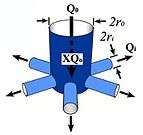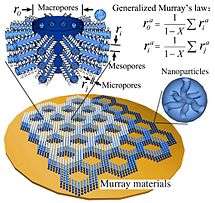Murray's law
Murray's law predicts the thickness of branches in transport networks, such that the cost for transport and maintenance of the transport medium is minimized. This law is observed in the vascular and respiratory systems of animals, xylem in plants, and the respiratory system of insects.[1][2][3][4] Its simplest version states that if a branch of radius splits into two branches of radii and , then . Like Hagen–Poiseuille equation and Fick's laws, which were also formulated from a biological context, Murray's law is a basic physical principle for transfer networks.[2][4]
Murray's law is also a powerful biomimetics design tool in engineering. It has been applied in the design of self-healing materials, batteries, photocatalysts, and gas sensors. However, since its discovery, little attention has been paid to exploit this law for designing advanced materials, reactors and industrial processes for maximizing mass or energy transfer to improve material performance and process efficiency.[3]
The original version of Murray's law is only applicable to mass-conservative transport in the network. There are generalizations for non-conservative networks, which describe effects such as chemical reactions and diffusion through the walls.[1]
Murray's law in mass-conservative networks
Murray's original analysis[5][6] is based on the assumption that the radii inside a lumen-based system are such that the work for transport and upkeep is minimized. Larger vessels lower the expended energy for transport, but increase the overall volume of blood in the system; blood being a living fluid and hence requiring metabolic support. Murray's law is therefore an optimisation exercise to balance these factors.
For child branches splitting from a common parent branch, the law states that:
where is the radius of the parent branch, and are the radii of the child branches. This law is only valid for laminar flow, since its derivation uses the Hagen–Poiseuille equation as a measure for the transport work (see below). Williams et al. deduced the formula for turbulent flow:[3]
Derivation
As stated above, the underlying assumption of Murray's law is that the power (energy per time) for transport and upkeep is minimal in a natural transport system. Hence we seek to minimize , where is the power required for transport and the power required to maintain the transport medium (e.g. blood).
Laminar flow
We first minimize the power of transport and upkeep in a single channel of the system, i.e. ignore bifurcations. Together with the assumption of mass-conservation this will yield the law. Let be the laminar flow rate in this channel, which is assumed to be fixed. The power for transport in a laminar flow is , where is the pressure difference between the entry and exit of a tube of radius and length . The Hagen–Poiseuille equation for laminar flow states that and hence , where is the dynamic viscosity of the fluid. Substituting this into the equation for , we get
We furthermore make the assumption that the power necessary for maintenance is proportional to the volume of the cylinder :
where is a constant number (metabolic factor). This yields
Since we seek the radius with minimal power, we calculate the stationary point with respect to r
With this relationship between the flow rate and radius on an arbitrary channel, we return to the bifurcation: Since mass is conserved, the flow rate of the parent branch is the sum of the flow rates in the children branches . Since in each of these branches the power is minimized, the relationship above holds and hence, as claimed:
Diffusion
The power for transport spent by diffusion is given by
where the flow rate is given by Fick's law, whose is the diffusivity constant and is the difference of concentration between the ends of the cylinder. Similarly to the case of laminar flow, the minimisation of the objective function results in
Hence,
The generalized Murray’s law
However, the special Murray’s law is only applicable to flow processes involving no mass variations. Significant theoretical advances need to be made for more broadly applicable in the fields of chemistry, applied materials, and industrial reactions.

The generalized Murray's law deduced by Zheng et al. can be applicable for optimizing mass transfer involving mass variations and chemical reactions involving flow processes, molecule or ion diffusion, etc.[1]
For connecting a parent pipe with radius of r0 to many children pipes with radius of ri , the formula of generalized Murray's law is: , where the X is the ratio of mass variation during mass transfer in the parent pore, the exponent α is dependent on the type of the transfer. For laminar flow α = 3; for turbulent flow α = 7/3; for molecule or ionic diffusion α = 2; etc.
It is applicable to an enormous range of porous materials and has a broad scope in functional ceramics and nano-metals for energy and environmental applications.
Murray materials
The generalized Murray’s law defines the basic geometric features for porous materials with optimum transfer properties. The generalized Murray’s law can be used to design and optimize the structures of an enormous range of porous materials. This concept has led to materials, termed Murray materials, whose pore-sizes are multiscale and are designed with diameter-ratios obeying the generalized Murray’s law.[1]

As lithium battery electrodes, the Murray materials can reduce the stresses in these electrodes during the charge/discharge processes, improving their structural stability and resulting in a longer life time for energy storage devices[7] . This material could also be used for boosting the performance of a gas sensor and a photocatalysis process that broke down a dye using light[8].
_connecting_to_many_children_pores_(radius_ri)._.jpg)
To achieve substances or energy transfer with extremely high efficiency, evolution by natural selection has endowed many classes of organisms with Murray materials, in which the pore-sizes regularly decrease across multiple scales and finally terminate in size-invariant units. For example, in plant stems and leaf veins, the sum of the radii cubed remains constant across every branch point to maximize the flow conductance, which is proportional to the rate of photosynthesis. For insects relying upon gas diffusion for breathing, the sum of radii squared of tracheal pores remains constant along the diffusion pathway, to maximize gases diffusion. From plants, animals and materials to industrial processes, the introduction of Murray material concept to industrial reactions can revolutionize the design of reactors with highly enhanced efficiency, minimum energy, time, and raw material consumption for a sustainable future[9].
References
- Zheng, Xianfeng; Shen, Guofang; Wang, Chao; Li, Yu; Dunphy, Darren; Hasan, Tawfique; Brinker, C. Jeffrey; Su, Bao-Lian (2017-04-06). "Bio-inspired Murray materials for mass transfer and activity". Nature Communications. 8: 14921. doi:10.1038/ncomms14921. ISSN 2041-1723. PMC 5384213. PMID 28382972.
- Sherman, Thomas F. (1981). "On connecting large vessels to small. The meaning of Murray's law". The Journal of General Physiology. 78 (4): 431–53. doi:10.1085/jgp.78.4.431. PMC 2228620. PMID 7288393.
- Williams, Hugo R.; Trask, Richard S.; Weaver, Paul M.; Bond, Ian P. (2008). "Minimum mass vascular networks in multifunctional materials". Journal of the Royal Society Interface. 5 (18): 55–65. doi:10.1098/rsif.2007.1022. PMC 2605499. PMID 17426011.
- McCulloh, Katherine A.; John S. Sperry; Frederick R. Adler (2003). "Water transport in plants obeys Murray's law". Nature. 421 (6926): 939–942. doi:10.1038/nature01444. PMID 12607000.
- Murray, Cecil D. (1926). "The Physiological Principle of Minimum Work: I. The Vascular System and the Cost of Blood Volume". Proceedings of the National Academy of Sciences of the United States of America. 12 (3): 207–214. doi:10.1073/pnas.12.3.207. PMC 1084489. PMID 16576980.
- Murray, Cecil D. (1926). "The Physiological Principle of Minimum Work: II. Oxygen Exchange in Capillaries". Proceedings of the National Academy of Sciences of the United States of America. 12 (5): 299–304. doi:10.1073/pnas.12.5.299. PMC 1084544. PMID 16587082.
- http://www.greencarcongress.com/2017/04/20170407-murray.html
- https://www.msn.com/en-za/news/techandscience/leaf-veins-may-lead-to-longer-battery-life/ar-BBzDHW9
- https://uk.news.yahoo.com/leaf-vein-structure-might-help-114254703.html